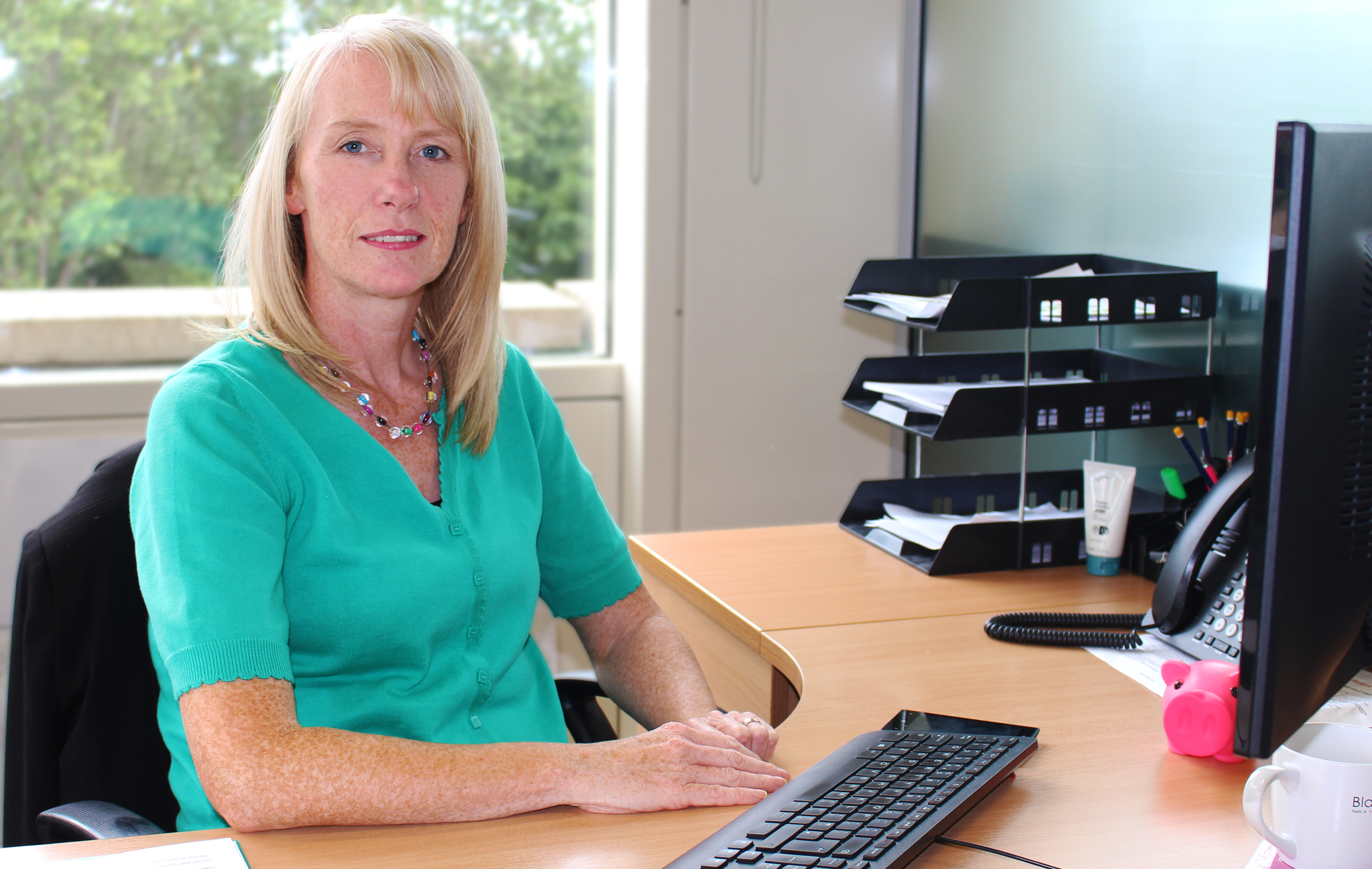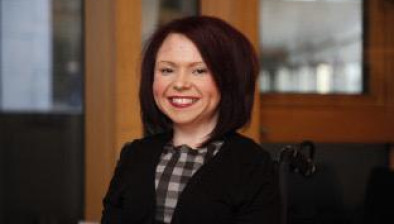Accessible housing (part 2) - podcast transcript

Angela Currie
Below is a full transcript of episode 61 of the Scottish Housing News Podcast titled ‘Accessible housing (part 2) with Angela Currie’. Listen to the episode here.
Kieran Findlay
Hello and welcome to the Scottish Housing News Podcast. We’re beginning to get very excited about our Housing & Social Care Accessibility Summit coming soon in September. So we’ve asked Angela Currie, the chief executive of Hanover Scotland to help us understand the big issues under discussion.
I’m Kieran Findlay, the editor of Scottish Housing News, and I’m joined by co-host Jimmy Black, and we’re delighted to share that Hanover Scotland is one of the sponsors for our Summit.
Jimmy Black
Angela, you’re an old friend of the podcast. We last spoke to you about Hanover’s Passivhaus development in Drymen. But this time we’re talking about accessible housing. So welcome back.
Angela Currie
Thank you. Great to be here.
Jimmy Black
Does the design of Scotland’s housing prevent some people from living independently?
Angela Currie
It does every day of the week. So much of our housing isn’t suitable for people with disabilities. And that’s partly because when they were built, they were built to design standards that are much older than we expect of today’s modern homes. So it has a really huge impact on the life that people lead if they’re living in homes that are unsuitable for them.
Kieran Findlay
If people who are differently abled can’t find the homes, what are the consequences then for local health and social care services?
Angela Currie
Well, if people are, say for example, stuck in their home, then the cost of delivering services to them because they, for example, nurses, other types of health services, people have to go out to visit them at home. Their mental health is likely to suffer. We’ve all read the reports about the dreadful impact of isolation and loneliness on people and the impact it has on their health. So there’s a whole huge cost to society, never mind to health and social care, to support people who are stuck at home.
Jimmy Black
Tell me, are people aware of what is on offer in Scotland? Because there are some providers like yourselves who are doing good stuff in terms of accessible housing. How do people find it?
Angela Currie
I think our research with our tenants tells us that people come across us quite often just by chance. And it’s a conversation they may have with a friend or a relative.
I don’t think anyone in health and social care, for example, who are usually advising people in a situation where their housing is unsuitable would automatically know in Scotland where to signpost them to, to get really good quality housing advice. And even then, there’s so many places to go. So if you think about there’s roughly 150 local authorities and housing associations in Scotland, then which one do you go to to get advice?
So it’s, I think it’s very difficult and even I’m sure you come across this a lot and even in your own life. If someone asks me, where do I work? And I say a housing association, usually the response is, ‘what’s that?’ So there’s a general lack of awareness of the housing sector and the options in it in Scotland, but there’s a lot of missing information out there in terms of how do you get access to specialist accommodation, where is it and what standard is it at? Is it a basic accessibility standard or is it fully wheelchair accessible for example? That’s a bit of a mystery as well when we use the word accessibility, isn’t it? Because it can mean so many things.
Kieran Findlay
So tell us a little Hanover then. We know you provide accessible housing. We know that you specialise in older people. Tell us something about the way that you design and deliver new homes or adapt existing homes to suit the communities and the people that you serve.
Angela Currie
Well, we, for any new house building, we have a design guide as many organisations do that reflects what’s required of us from a building standards perspective, but obviously Housing for Varying Needs.
But Housing for Varying Needs as we know is 30 years old now. So we’ve been building beyond that for some time now because it needs to be wheelchair accessible and everything we’ve built in recent years in the model of sheltered housing is wheelchair accessible. And, in fact, what we build is generally two-bedroom properties which allows that extra bit of room for people with large pieces of equipment or who need carers to stay over and just gives that little bit of extra room for anyone who is using a wheelchair or any mobility aid.
For our new homes, we do that as well as building a lot of dementia-friendly elements as well. So our design guide has 23 additional elements to it to reflect what we know about those who have dementia or might develop it.
So we try to future proof our new houses as much as possible. And we’re just reviewing that design guide while we wait for the Scottish Government to report on any changes to Housing for Varying Needs when the consultation results are published and the final version of that new accessible housing standard is published. And of course, for us, a big part of this next step will be the smart house that builds in all the technology-enabled care pieces as standard because right now we haven’t been doing that. So we’ve been fitting these things after someone moves in.
So that’s actually the easy bit, isn’t it? Because you can design new houses to your heart’s content now, knowing what we know. See our older stock though, particularly our older stock of the 80s, it is smaller. You know, it’s not built in a way that we would, the standard that we expect these days. So it’s pretty challenging.
The good thing is though, a lot of the sheltered housing developments, for example, do have lifts. They do have secure door entry systems. They do have an on-site development manager still. They have a common room and a kitchen. So there are some of the very helpful elements of the sheltered housing model in there. There might not just be the biggest space standards that we now come to expect in your house, in your houses.
Jimmy Black
Pam Duncan Glancy MSP, was our guest in the previous podcast. And she was saying that it’s incredibly important that disabled people themselves are included in the consultation when new houses are being designed or, you know, lets have been prepared for people with disabilities. Her example, a very practical example was don’t put carpets in if you’re creating a wheelchair house.
I’m sure you would never make that mistake. But how do you manage to involve people in the design of the houses? Because I think requirements constantly change.
Angela Currie
We have a very active tenant base who love to tell us how things work, how things don’t work. And as part of our review of our current design guide, we’ve gone out to the three large Housing with Care developments that we built up in Moray about eight or nine years ago now to say, ‘okay, what worked and what didn’t? And what would you do for this next generation of Hanover House based on the fact you’ve been living in it for some time now and you understand what works and what doesn’t?’
What we also can never forget to do is ask our care teams how it works for them because if you’re providing Housing with Care, you are also a registered care provider. So you have to build in all the requirements of our care team that meet Care Inspectorate requirements, for example, and even a space for what we call donning and doffing uniforms that manages infection control are incredibly important to put into buildings.
So we have to make sure we get the flow of the workforce coming in and out of the building right to manage infection control and all those sorts of things are so important for our teams to be effective that normal general needs providers don’t have to worry about at all when they’re designing their properties. So it’s really important for us to reflect on those sorts of requirements.
Kieran Findlay
I think it’s timely to mention that thanks to Hanover’s support for the Summit, we’ve been able to offer places to voluntary organisations and charities, some of which wouldn’t have been able to attend. So thanks again for that.
But it’s not just about bricks and mortar when designing these places. The right kind of care is essential as well, isn’t it?
Angela Currie
It really is. And it’s something we’re not talking enough about in Scotland. There’s an older people’s cross-parliamentary group in England that’s focusing a lot on housing models for older people. It’s really got a bit of a spotlight on it just now. But we’re not talking about it at all in Scotland. And in fact, I think the risk is we’ll be talking less about it as the budget cut starts to bite in terms of the Affordable Housing Programme. And because of the housing crisis we have, I think there’ll be a tendency to build general needs because we’ll get higher volume for our buck, because specialist housing costs more.
And yet we’ve got a massive demographic emergency coming our way in terms of the number of older people in this country. The vast majority of whom are living in homes that will become unsuitable for their needs. And if there’s nowhere for them to go that provides independent living, then the strain on places like nursing homes and care homes and hospital wards for older people will completely break the system and a system that is close to being on its knees already.
Jimmy Black
So we’ve got this system of sheltered housing which has existed for decades and we seem to have been running that down over the last few years and going for amenity housing and not having wardens on site and that kind of thing. We’ve also got this idea that you have general needs housing and you bring the care into the general needs housing when it’s required. And then we have this new thing called Housing with Extra Care, which is what I think you’re talking about, which involves a whole lot of other services being supplied, I think maybe in a bespoke environment for older people or people with disabilities. And that third one is obviously much, the most expensive of the options.
How can we actually realistically achieve that ideal form of housing for people?
Angela Currie
It takes obviously the three partners to work together really closely in terms of health and social care, recognising what the demand is or the future demand might look like in their area and working with their housing partners to deliver that and not just from an asset building and capital investment piece but also what’s the service delivery model because that model that you’re describing, Jimmy, has a bit of a bad reputation doesn’t it? The old-fashioned sheltered housing model is often seen as not fit for purpose anymore and has a bit of a stigma attached to it.
But if you came to any one of our modern extra care or Housing with Care, whatever you want to call it, developments, then they are vibrant hubs that every time you go and visit and you speak to one of the tenants, they say to you, ‘I wish I’d moved here five years ago because I’ve got a ready-made family and community, services come to me and I feel so much better in terms of my wellbeing being in this environment that I could never have had living on my own in a house that’s too big for me and maybe in a street where there’s no people of the same age that you can connect with and you know and do all the social activities that you get in that group living situation’.
So I think the benefits of it are overlooked at times because we still have the stigma attached to it as a, it’s a care home, pseudo care home model.
Kieran Findlay
To change the landscape on accessible housing, I guess you need a whole lot of people to come together, thinking health and social care, planners, housing, Scottish Government, private developers, and most importantly, perhaps lenders. We’re hoping that our Summit will go some way towards forging these relationships between the sectors, but changes can take a long time. I’m thinking specifically of the Scottish Accessible Housing Standard.
You’ve been pretty successful in developing properties that bring all these places together. How have you forged the relationships and how do you manage to convince people to go that bit further?
Angela Currie
I think local authorities through their housing and demand assessments have a good feel for their population and the needs of that population in terms of housing demand. So that really helps. And for some local authorities, it’s very clear that there’s an ageing population. The census and all the demographic information is being used well to demonstrate that need. So you’re pushing out an open door quite often from a housing development perspective in terms of getting opportunities to be embraced in terms of the Strategic Housing Investment Plan.
So that seems relatively easy to us because it’s hard to argue against the statistics, isn’t it? I think what the challenge hasn’t been so far about getting the grant as such, the Affordable Housing Programme grant or subsidy as we call it, the challenge for us in that environment is the level of funding. So although it costs more to build specialist housing, you don’t get the grant to cover the whole of the building. You only get the grant to cover the whole of the social housing tenancy element. So we actually get less grant overall than general needs housing, which I don’t think is well understood.
And of course, the biggest challenge we have is how do you bring social care into that discussion around building these types of developments if you want to also be the care provider. So we have real challenges because the commissioning environment that the social worker health and social care partnership work within often means you have to tender for that service that you want to deliver in your own development. And the procurement rules in Scotland are often waived under our nose to say, no, no, we can’t just give you that contract to allow your team to deliver this service in your building because procurement laws and of course that is absolute nonsense there are absolutely legitimate ways around that but the fear of getting procurement wrong is what actually stops us having good relationships at times and getting good outcomes for our business.
And all it ultimately means is we take all of the risk we put all of the capital finance in, in terms of borrowing, and we put our care team in hoping we’ll get the contract and we carry the whole risk of that through the lifetime of a building and that doesn’t feel right at all.
And we often are cited as a partner, housing is often cited as a strategic partner for health and social care, but we’re not treated as a strategic partner generally when it comes down to the nuts and bolts of getting things to work. So it does take a lot of time and effort for me and my teams to forge those relationships with the right people to get anything really to work in practice and that takes a huge amount of time and effort.
Jimmy Black
How many IJBs or Health and Social Care partnerships do you have to work with across Scotland?
Angela Currie
We have 23 would you believe and we have deliberately though narrowed that down to the top six that we really want to have strategic partnerships with because we couldn’t possibly spread ourselves that thin.
And that allows us to really pick an area that we want to work in, that we have those strong relationships and that those, that health and social care piece is a good working relationship. And we know there are people who we can work with and they understand, you know, how much housing can contribute to their strategic aims.
Jimmy Black
Can we talk a little bit more about the Scottish Housing Accessibility Standard? That seems to have been getting put together for such a long time and we may be getting closer to it. I think it might be published before terribly long. But it could be different, isn’t it, for the private sector, for the housing association sector, for council sector? Is it going to be a coherent standard that’s actually going to do the job in your opinion?
Angela Currie
Well, it will be very interesting to see what comes from the consultation. About 10 years ago now, Julia Fitzpatrick, who was the previous chief executive at Horizon, and I were on a national accessibility group run by the Scottish Government. And we’d turn up every quarter and say, please, please review Housing for Varying Needs really now needs to be done not just for the social housing sector who generally go beyond that standard anyway but to bring private sector homes into line.
And we actually got asked at the time if we would do that review and then we had a chat about it and looked at the document and said it’s actually a huge job you’re going to need really technical specialist people to do this but here’s some ideas and we gave them two really simple ideas, make it absolute for every new house built in Scotland, because if you don’t do it now, and by the way, this was 10 years ago, if you don’t do it now, we’ve got a crisis coming our way.
And why don’t you just get every house that’s available for let or for purchase to have an accessibility rating added to the home report or the advert for that property that tells you a basic accessibility standard rating so you know. And the reason that Julia and I came up with that was I had just moved into my current house. And when I’d looked up the home report and the pictures online before I went to view it, nothing was mentioned about accessibility, yet I drew up outside the front door, could tell right away the doors were slightly wider. It was complete level access.
And lo and behold, this whole development that I live in that’s something like 15 years old now, is they’re all fully accessible on the ground floor. And no doubt there was something going on with that developer at the time that they decided to do it. I had no idea. So if you’re someone looking for an accessible home, I heard your previous podcast with the MSP who gave some examples of her experience of rocking up to homes and immediately realising they’re never going to be suitable. So how does anyone with any mobility needs, never mind a wheelchair user, know what’s available out there? So something really simple like an accessibility rating would make life so much easier for people and would be relatively easy to do.
So I’m really looking forward to what comes back to us from that consultation exercise, Jimmy, because we suggested that again as part of our response to that, that we don’t just look at the building regs and the new standard, that we also think about the whole system and how it works.
Kieran Findlay
Yeah, was Pam Duncan-Glancy and she was saying that just this extra information being readily available for everybody really is relatively straightforward to do and at the moment it just doesn’t seem to be happening.
But one of the speakers we will be hearing from at the summit is housing minister Paul McLennan. What would you like to hear from him and what would you be asking of him if he didn’t mention it?
Angela Currie
Well, I’m disappointed that the minister responsible for social care won’t be there on the day.
Kieran Findlay
That is something that we try to do, yeah.
Angela Currie
Yeah, I think we absolutely need to recognise that housing can’t do what it needs to do on its own. And we need a strong commitment from the Scottish Government to work in partnership and to really, again, like your previous podcast speaker said, we need to work together to think about the future and design solutions together and not have housing take all the risk because that really limits how much we can do and we’re small organisations compared to these huge businesses.
If we don’t grab and grab with both hands that prevention agenda, do more now, given we know what’s coming our way from our demographics, then we are going to be in a much worse state than we are now in 10, 20 years time. So can we get people together genuinely at senior level, round the table and start to work through some big issues of how we can work better together.
Jimmy Black
Earlier this year, Hanover established an annual award in memory of Julia Fitzpatrick, who was a board member. And I remember Julia Fitzpatrick and correct me if I’m wrong, Angela, but I recall when I met her, she was trying to organise ways for people with disabilities to actually buy houses. It was a kind of innovative scheme that she was involved in.
Can you just share a few words about Julia and how the prize that you’re sponsoring aims to celebrate her legacy as a champion of equitable housing.
Angela Currie
Yeah, Julia was such an inspiration and a huge campaigner on accessible housing issues. And her involvement on our board, she was on our board for a number of years, was huge in terms of supporting us to think through what our strategic purpose is as an organisation in terms of providing accessible housing for older people. But she did it with such a, she’s one of these people who has a lasting impact on you because she has such integrity, such intelligence, and is such a kind and warm person who truly believed in the cause.
So her legacy for us has been huge, but for the sector as we know, it was big as well. And that piece that you mentioned that Jimmy was only one of the things that she really started a big debate on. And the other one, of course, is adaptations, which for me is still a real source of frustration because most of our houses in Scotland, as you know, are quite old. And adaptations is a big part of supporting people to live well at home independently.
And yet we’re sitting in August and we don’t know what our allocation this year is from the budget from the Scottish Government. And so once again, we’re putting all our money into that and carrying the risk that we might not get anything at the end of the day, but we would never stop doing it because it’s the difference between someone lying in a hospital bed for three months or coming home to a house that’s now just been adapted to meet their needs.
So Julia’s legacy for us was on so many levels, we felt we really wanted to honour her commitment to this agenda by having this award each year in recognition of what she’s contributed and it’s great to see Horizon really being at the forefront and organising this event which I think speaks a lot to Julia’s memory.
Kieran Findlay
Am I right in saying it’s the staff award for Hanover?
Angela Currie
It is, yeah.
Kieran Findlay
Excellent. We’ve got some top speakers coming to the summit, really knowledgeable people from public, private sectors and the third sector. Is there anyone in particular that you are excited to hear from?
Angela Currie
I think it’s really good to hear from the academics and so on, but I think it’s important that we hear from the people in IJBs because they are the people who have the power but are also equally frustrated at times because of the challenges that they face. So I think it’d be really good to hear from them that they recognise housing and see us and realise that we should be a strategic partner at the big table rather than a non-voting silent partner in a lot of these cases, it feels like we’re there to be tolerated as opposed to be cherished and understood as a key part of the fabric of society in Scotland and not just this annoying bunch of people who always want to talk about housing.
Kieran Findlay
Thanks, then before we go, I would just like to check up on Mrs Nicholson who I visited in the Drymen development. How is she doing?
Angela Currie
Brilliantly and still loving the fact that she could contribute to the podcast and be part of showing you that lovely home she’s in.
Kieran Findlay
It was tremendous and I love the area as well. I managed to take the family with me that day so we spent some time at Loch Lomond afterwards so that was great.
Right, we’ll wrap up there for the second part of our look at accessible housing. Thanks to Angela Currie, the chief executive of Hanover Scotland. Thanks to my co-host, Jimmy Black, and we’ll be back with another episode on accessible housing in a couple of weeks.









